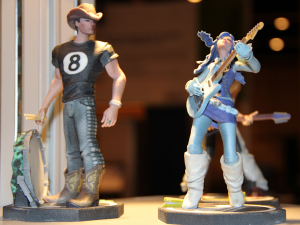3D Printing – This Time Your Action Figure Is for Real
By Hervé St-Louis
September 9, 2012 - 16:35
 |
| Source: netfabb GmbH |
By toys, I mean not just action figures, but anything you would like to build. It could be a replacement case for your smartphone, or a new complete box casing for your actual phone. It could be a new bumper for your Honda Civic or a new shell for the television monitor’s frame that was damaged the last time you moved. 3D printing depends on the availability of 3D models and that’s where the problems begin. There are a few way to build 3D models. You can scan an existing object with a 3D scanner, the same way you would scan the page of a comic book. You could build a model yourself, using a 3D modeling program like Rhino or Cinema4D. Or you could somehow obtain access to the industrial model built in something like SolidWorks used by a manufacturer to build an object. For example, if you could get your hand on the SolidWorks model of a Samsung Galaxy, you know, if such a thing was ever leaked, with the right prototyping 3D printer, you could build the full casing of your smartphone exactly as it was designed by Samsung.
Soon, the same way music lovers easily have access to music tracks online, scanlation of comic books or the latest Hollywood blockbuster, average users will have access to a plethora of 3D models of common objects to replace parts of their cars, their phones, tables, computers, cutlery, toys, remote controls and so on. However, the right to use these models will be viciously guarded by manufacturers, as BoingBoing’s Cory Doctorow argues frequently.
 |
| Source: netfabb GmbH |
What 3D printing offers is an opportunity for consumers to be involved in the process of producing the goods they consume. Hobbyists will be the first to take advantage of 3d printing. They will be the ones producing limited runs of custom action figures of their favourite super heroes. They will be the ones recruiting local artists to airbrush their action figures and sand them smoothly. They’ll be hiring local designers to create neat packaging for their products. Some will be more enterprising than others. One of them will start creating an assemble yourself futon bed made of plastics. At once this will encourage the local artisans to hunt their local thrift stores for fabrics to create cushions in delectable patterns. That’s what I really hope 3D printing will do. Instead of buying stuff from overseas, we’ll be buying unique piece of furniture and action figures from local modellers who work with local artisans to reuse older materials and combine them with the plastic materials used as the core of a new bunch of unique products.
I look forward to that specific future of 3D printing more, than I do with the DRM one where police detectives will crack open people’s computers looking for the copies of bootlegged 3D designs of the latest iPad.
Related Articles:
How does 3D Printing Work?
3D Printing – This Time Your Action Figure Is for Real
Will 3D Printing Change Action Figure Collecting?
